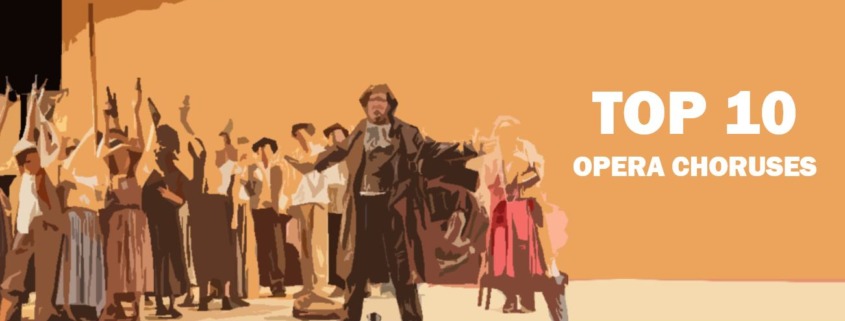Best of Opera – MOST BEAUTIFUL songs for CHORUS – Top 10
A compilation of the most beautiful pieces for choir with explanations and great YouTube videos.
TOP 10 OF THE PIECES FOR CHOIR
10
CORO A BOCCA CHIUSA
from MADAMA BUTTERFLY by Giacomo Puccini
Plot: Butterfly is at home. Suddenly, cannon shots ring out. It is the Abraham Lincoln. Butterfly is sure Pinkerton is returning with the ship! She goes to the garden and together with Suzuki starts to pick all the flowers and decorate the house. The house and the bride should be decorated as they were on the day of the wedding. Butterfly puts on her wedding dress and waits for Pinkerton.
The conclusion of the second act is made by the so-called Summ Chorus, a beautiful and unusual conclusion. A chorus of sopranos and tenors hum a nostalgic melody at octave intervals backstage, accompanied by a solo viola, pizzicato strings, winds and the rest of the orchestra.
9
WAS GLEICHT WOHL AUF ERDEN (HUNTER CHORUS)
from DER FREISCHÜTZ by Carl Maria von Weber
Plot: Today is the solemn day of the trial shot, by which Max is to acquire the position of hereditary forester. In the presence of the prince, the hunters are waiting for Max in the tavern.
The famous chorus with the blaring horns became the epitome of German Romanticism.hle ecstatic top notes to produce.
8
DIN DON (BELL CHORUS)
from PAGLIACCI by Ruggero Leoncavallo
Plot: In a Sicilian village on Sunday morning. The church bells are ringing, it’s time for mass. A solemn procession runs through the village.
Leoncavallo was inspired by Mascagni’s “Gli aranci olezzano” from “Cavalleria rusticana”, and he wrote a piece with the most beautiful local color. The choir voices imitate the bells of the church.
7
DANSE DES FURIES
from ORFEO ED EURIDICE by Christoph Willibald Gluck
Plot: Orfeo wants to enter the underworld. But in front of a ghostly cave by the River Styx, hidden by clouds of smoke, dance the Furies who guard the entrance to the underworld
Gluck paints a magnificent picture of the Furies, and the music sounds immensely modern. Carried by the tremolo of the strings and whipped up by winds, the chorus sings in unison no melodies, only thirds.
6
IN OUR DEEP VAULTED CELL
from DIDO AND AENEAS by Henry Purcell
Plot: The head witch wants to plunge Dido into misfortune. Fame, love and life are to be taken away from her. The witches are excited and want to know how this will happen. The sorceress explains that a spirit in Mercury’s form will appear to Aeneas, admonishing him to set sail and seek out Italy. But first they want to cause a storm that will drive Dido and Aeneas from the forest back to their courtyard on the day of the hunt. The Furies perform a dance in celebration.
This piece is also called “Echo Dance of the Furies” because Purcell has short choral passages repeated over and over by a choir in the background as an echo. A surprising and charming effect!
5
CARLO IL SOMMO IMPERATORE
from DON CARLO by GIUSEPPE VERDI
Act:In the monastery of San Giusto. Monks sing a psalm.
The opening scene of the second act is a great, effective church mass scene. The choir of monks sounded in the famous “chiaroscuro”, the alternation between light major and dark minor. The passage is reminiscent of the priestly scenes in Nabucco and ends with a beautifully painful cantilena in the strings.
4
SU! DEL NILO AL SACRO LIDO
from AIDA by Giuseppe Verdi
Plot: The priest calls on the Egyptians to resist the invaders. In a great crowd scene, the priest and the king whip up the crowds.
This passage features a great choral scene with the irresistible anthem of the warring Egyptians.
3
O WELCHE LUST (PRISONER CHORUS).
from FIDELIO by LUDWIG VAN BEETHOVEN
Plot: Leonore is desperately searching for her husband in prison. Hoping to catch sight of Florestan, she has the prisoners take a walk in the courtyard. But she cannot discover him.
In the prisoners’ chorus we already hear the idyll of the Pastorale, which Beethoven will compose only two years later. It is a stroke of genius that Beethoven composed the hope of the prisoners with such heartfelt music. No wonder Verdi felt inspired to compose a second famous prisoners’ chorus forty years later.
Listen and watch a magical and hypnotically sung interpretation by Maria Ewing in the film adaptation by Jean-Pierre Ponnelle.
2
DA ZDRAVSTVUET (LONG LIVE OUR TSAR)
from BORIS GODUNOV by Modest Mussorgsky
Plot: A square in the Kremlin. The people are waiting for the coronation ceremony in front of the church. A procession makes its way to the cathedral for the coronation of the new tsar Boris Godunov.
The scene is also known as the “Coronation Scene”. Mussorgsky worked long on the sound of the church bells, his friend and sometime roommate Rimsky-Korsakov helped him. They sound right at the beginning of the Coronation Scene. The bells of the Orthodox church have a peculiar and complex sound; moreover, the interplay of the bells has no harmonic foundation. Mussorgsky imitated the sound of these bells with two chords, which together create an atonal moment that has a fascinating effect on the listener. The orchestral bells sound expressive and modern, and the listener feels transported forward in time 50 years to Bartok.
A beautiful canon-like church chorus is then heard, with Mussorgsky creating a tremendous crescendo and ecstatic effect with steadily increasing instrumentation during its repetition. In the second part of the choral movement, he begins to alternate three-fourths and two-fourths measures, anticipating an important stylistic device of later periods.
1
BEGLÜCKT DARF NUN DICH, O HEIMAT, ICH SCHAUEN (PILGRIM CHOIR)
from TANNHÄUSER by Richard Wagner
Plot: The chorus of pilgrims who have made the long journey to Rome to see the Pope.
In the style of the Grand Opéra, Richard Wagner created this overwhelming choral passage



A little confusing. The soprano (who doesn’t sing) in this excerpt is Gundula Janowitz. Are your referencing another Fidelio with Maria Ewing?